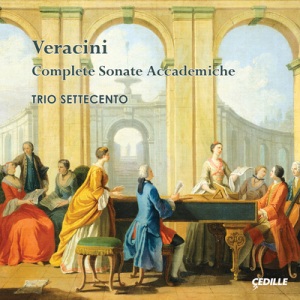In her personal comments included in this disc’s liner notes, violinist Rachel Barton Pine laments the fact that, although they used to be concert staples of great virtuosos of the past, “Veracini’s wonderful sonatas are no longer performed by today’s modern concert violinists.” This is certainly sad and undeniably true, but in defense of this music’s worthiness she also makes a claim that at first, and especially to the uninitiated, seems extremely bold: that these sonatas “exemplify the greatest achievements of virtuosity and imagination in the High Baroque.”
Before you question that assertion, you should realize that Pine has lived with, studied, analyzed, and performed these works for years; she knows very well the Baroque repertoire; and she is herself one of today’s important virtuoso concert violinists. The real proof, of course, comes with listening, and it doesn’t take long to appreciate that Pine is not exaggerating at all: there’s enough imagination and virtuosity on these three well-filled discs to keep avid fans of the violin pleasantly occupied for many hours, many hearings and re-hearings.
The Sonata No. 1 begins innocently enough, with a series of slow ascending and descending arpeggios with alternating violin and cello; but then the music becomes slightly more elaborate, a little ornamentation here, a hurdy-gurdy drone effect there, a touch of bowed vibrato and double-stop tremolo, followed by a sudden flamboyant solo violin passage that seems to set the course for the rest of the movement. But just as suddenly, the music slows and nearly stops; the continuo returns, followed by another rapid solo-violin passage. So, it’s very quickly clear we’re in for something different–an impression that’s more than confirmed with the second movement (Capriccio), a fugal dialogue between cello and violin with the latter swirling and whirling with all sorts of virtuoso flourishes, marked by numerous register and dynamic shifts that sometimes make you think there must be more than one violinist at work.
And so it goes, for one after another of these sonatas, all of them different–some quite different from anything we might hear from Veracini’s contemporaries. For one thing, these 12 sonatas, published in 1744, are incredibly substantial pieces, ranging from 12-plus minutes to more than 20, and the variety and range of invention, from themes to fugal sections to variations, from the careful attention to both effect and affect in employment of technique, including improvisational-sounding passages, sonic indulgences, and the occasional sheer revelry in “traditional tunes” marks these as very special, unique creations that require special, caring attention, and, yes a virtuoso technique and spirit to pull off. Pine and her colleagues’ ability to do this (and Veracini’s clever invention) is no better exemplified than in Sonata No. 9, a piece surprisingly rooted in traditional Scottish fiddle music, the bowing and ornamentation and dancing character sounding as authentic as could be due to some coaching from “master Scottish fiddler John Turner and the faculty of the Jink and Diddle School of Scottish Fiddling”.
You might think that three very full discs of violin sonatas by one composer is a bit too much–and perhaps it is for one sitting; but unlike the work of some other composers of the period, Veracini’s sonatas don’t stick to a formula, nor do they always do what you think they are going to do. So you’re always in for a surprise, not to mention, as realized by Pine, an often dazzling display of violin wizardry. Of course Pine benefits from the long collegial relationship with her trio partners and from the excellent sonics from Cedille’s recording team. Incidentally, Pine plays an unaltered 1770 Nicola Gagliano violin, John Mark Rozendaal plays a David Tecchler cello from 1705, and David Schrader’s single-manual harpsichord (an ideal ensemble partner with the two strings) is tuned in unequal temperament–all of which will appeal to period enthusiasts, but more importantly, lends an indefinable richness and extraordinary vibrant quality to the sound. Highly recommended.
































